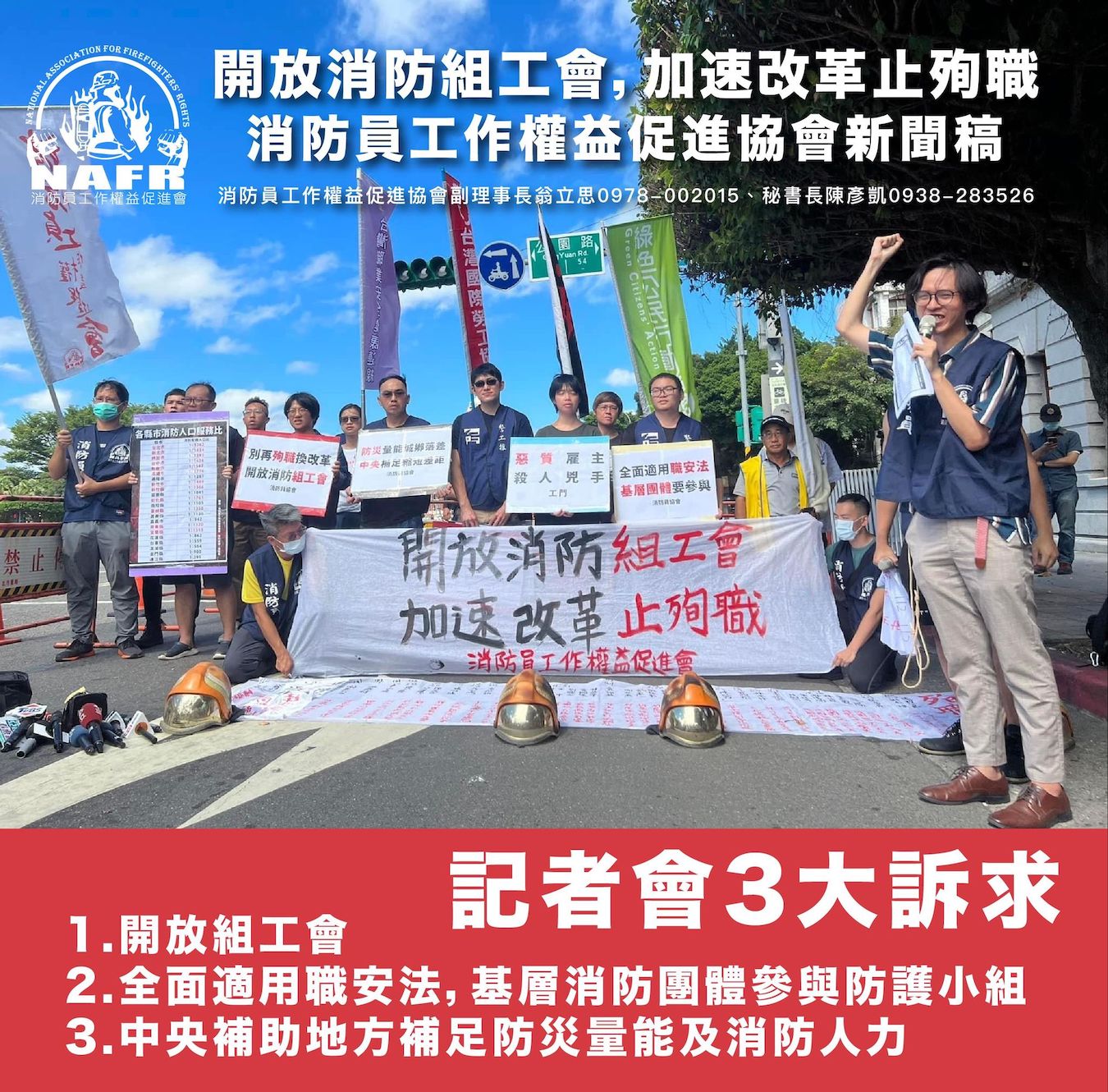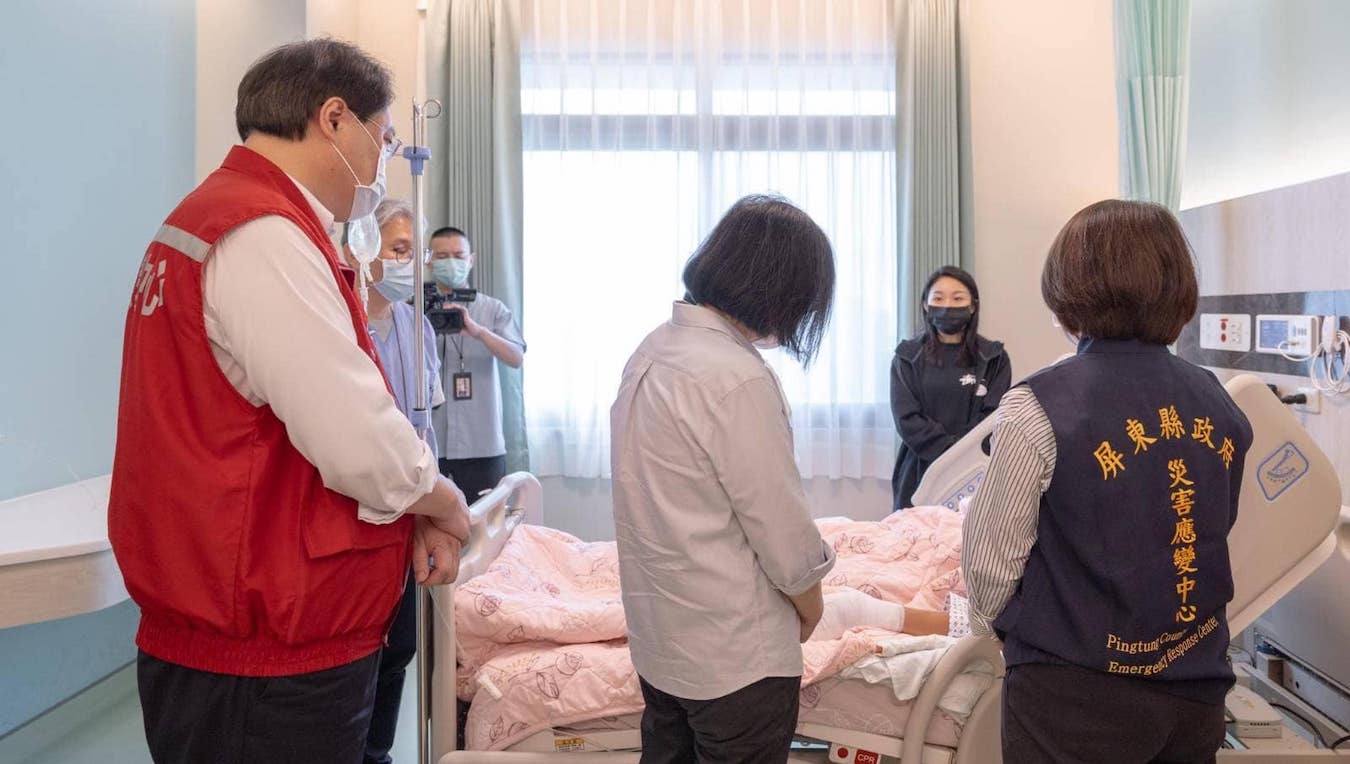by Brian Hioe
語言:
English
Photo Credit: Tsai Ing-wen/Facebook
THERE HAVE BEEN calls for improving safety measures for firefighters after a blaze killed four firefighters in Pingtung on Friday. Subsequently, the National Association for Firefighters’ Rights (NAFR) demonstrated on Ketagalan Boulevard on Saturday with a banner listing the names of the 39 firefighters who were killed in the line of duty in the past decade. The incident points to the need for a number of fundamental safety reforms.
A total of nine were killed in the fire, with 109 injured and one missing. The four firefighters who died were in their thirties and stories of their young families have struck a chord with the public.
The fire broke out at a Pingtung factory owned by Launch Technologies Company, a manufacturer of sports equipment. After receiving a call at 5:31 PM, firefighters responded quickly and arrived on-site at 5:43 PM, within twelve minutes. However, an explosion took place at 6:09 PM, trapping several firefighters under rubble. Another explosion occurred at 6:28 PM. The explosion could have occurred due to peroxide stored in the factory.
 The press conference held by the NAFR. Photo credit: NAFR/Facebook
The press conference held by the NAFR. Photo credit: NAFR/Facebook
Initial statements by Hsu Mei-hsueh, the head of Pingtung County’s Bureau of Fire and Emergency Services, suggested that the explosions occurred after firefighters tried to douse the blaze with water. Namely, water can cause explosions or react in unpredictable ways when mixed with chemicals. Hsu later stated that she misspoke and that firefighters responded with dry agents to the fire, as it was unknown what chemicals could potentially be in the factory.
The NAFR had a number of demands during its demonstration on Saturday, including calling for an increase in funding for firefighting and emergency departments, with greater resources provided to local governments by the central government. Likewise, the NAFR called for the inclusion of firefighters in the Occupational Safety and Health Act and the decision-making process for the Public Servant Health and Safety Act.
In particular, the NAFR’s key demand was for firefighters to be allowed to unionize, with the view that this would allow for firefighters to advocate for their interests and secure better protections. Nevertheless, this is complicated by the fact that firefighters are classified as public servants in Taiwan and, consequently, not allowed to unionize. The demand by firefighters to be allowed to unionize would also affect the ability of teachers, police, and other categories of public servants to unionize. This also touches upon the demand by workers in state-owned enterprises who currently have unions, such as among Taiwan Railways Workers, to be treated as public servants.
The Taiwan Society for Burn Injuries (TSBI) has stated that there is enough cadaveric skin to be used to treat burn victims, to provide skin grafts several days after the burn. 150,000cm2 is in reserve for the victims and TSBI chair Huang Hui-fu stated that this should be adequate to provide for the victims.
The TSBI called for the establishment of a national bank of human cadaveric skin after the Formosa Fun Coast water park fire in 2015. A dust blaze that resulted from airborne clouds of corn starch igniting burned 508, with 199 left in critical condition and 15 killed. The blaze spread into multiple dust clouds because staff at the park used carbon dioxide-based fire extinguishers to try and put out the blaze, further spreading the fire as visitors at the water park ran to try and escape the blaze. At the time, the Taiwanese government had to import 700,000cm2 of cadaveric skin to treat the victims, resulting in a delay of fifteen days.
Yet apart from issues regarding Taiwan’s medical system for treating burn victims or the rights and protections of firefighters, fundamental issues of industrial safety are also significant. Data provided by Launch Technology Company to authorities about what chemicals were present were apparently insufficient and incomplete. This has been a contributing factor to fires that killed firefighters in the past, in that too little was known about the structural layout and chemical storage at factories for first responders.
 President Tsai Ing-wen visiting victims of the blaze at the hospital. Photo credit: Tsai Ing-wen/Facebook
President Tsai Ing-wen visiting victims of the blaze at the hospital. Photo credit: Tsai Ing-wen/Facebook
And, though firefighters have certainly been among the victims of such blazes in past years, so, too, have migrant workers who are employed in such factories. Migrant workers are sometimes victims because they stay in dormitories built adjacent to factories in which dangerous, inflammatory chemicals are stored, and in which there are lacking fire safety measures. Unfortunately, Taiwanese employers commonly cut corners with safety for such factories, resulting in dangerous conditions for migrant workers. Just on Sunday, eight migrant workers were injured after a gas explosion in a residential building in Tainan.
The Pingtung Branch of the Bank of Taiwan has set up an account with the number 017000000000 for donations to the families of victims. The name of the account is 屏東縣縣庫存款戶 and donations should be marked “0922火災爆炸事件捐款” or “0922火災爆炸事件捐助警消人員” in footnotes in Chinese.
It is to be seen if the issue becomes a political flashpoint in a manner that leads to change. All presidential candidates have vowed to take action, with current president Tsai Ing-wen visiting the site of the disaster to show her concern, the Ministry of Labor stating it will investigate factories, and legislators calling for an improvement in fire safety equipment. At least Ko Wen-je has vowed to support firefighters being allowed to form unions, while Terry Gou has stated that he supports creating firefighter schools to provide better education.

